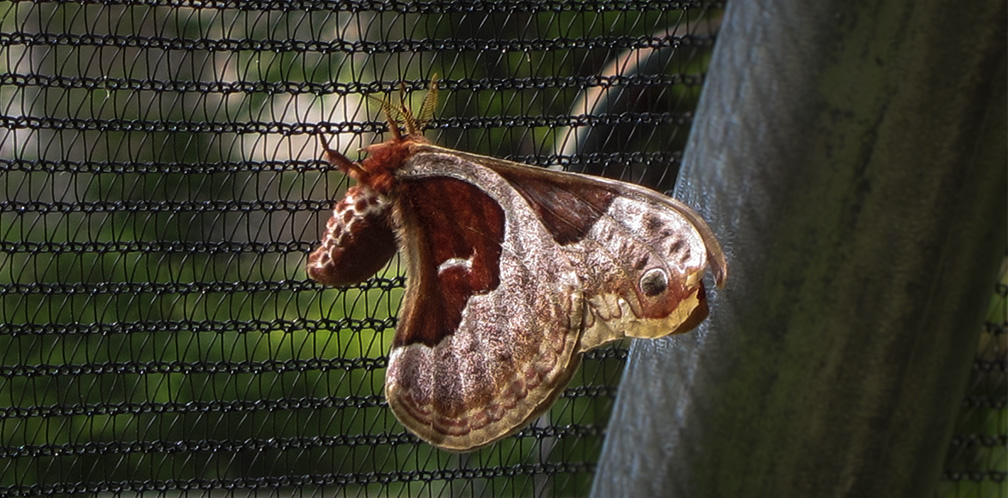Butterflies & Moths of the Adirondacks:
Promethea Silkmoth (Callosamia promethea)

The Promethea Silkmoth (Callosamia promethea) is a large moth which may be seen in the Adirondack Mountains in upstate New York in late May and early June. [1] It is also called the Spicebush Silkmoth – a reference to one of its many host plants.
This insect is a member of the Saturniidae family, which also includes the Luna Moth, the Cecropia Silkmoth, the Rosy Maple Moth, and the Columbia Silkmoth. Silkmoths derive their name from the fact that the caterpillars of some species spin large silken cocoons in which to pupate. [2] The Promethea Silkmoth is diurnal; it is mainly active between 3:00 to 6:00 PM, although females may fly at night. [3]
Female Promethea Silkmoths are very different from males in appearance. [4] [5]
- The female Promethea (seen above) has dark brown to reddish wings with tan borders and small white-cream polygons in the middle of each wing. The female Promethea Silkmoth is similar to the Cecropea Moth. [6]
- The male Promethea, by contrast, is very dark. Males have a bluish-black body; [16] their wings are nearly black with white/cream patterns along the wing margins. [7] [8]
The wing span of this moth is 2 15/16 to 3 3/4 inches. [9] The Promethea has rounded wings and feathery antennae. [10]
Most mating occurs in the afternoon, from 4:00 PM to sunset. During the night, female Promethea Silkmoths lay rows of 4-10 eggs on the top of host plant leaves. [11] Host plants include a broad range of plants such as spicebush, sassafras, lilac, and Black Cherry. [12] [13] Its wide variety of host plants allows this species to exist in many different habitats. The caterpillar spins a compact cocoon which hangs by a silken stalk from a twig throughout the winter. [14] [15] Adult Prometheas, which emerge in the spring, do not feed. [16]
Promethea Silkmoths favor deciduous woodlands. [17] The Promethea may be found throughout the eastern US and adjacent areas of southern Canada south to the Florida panhandle and west to Minnesota and eastern Texas. [18] [19] [20]
The potential flight period of the Promethea Silkmoth in the Adirondack Mountains is late May to mid-July. In 2012, Project Silkmoth recorded Promethea sightings in late May and early June. [21] These records suggest that the Promethea is less common in our area than the Luna Moth or Rosy Maple Moth. [22] A female Promethea was present in the Paul Smiths VIC Native Species Butterfly House in mid-June of 2012; the Butterfly House also hosted Promethea caterpillars in late June. [23]
References
- Susan Grimm Hanley. Interpretive Naturalist, Paul Smith's College Native Species Butterfly House. Species Logbooks.
- Butterflies and Moths of North American. Species Profiles. Sighting record: 6/16/12.
- Project Silkmoth. Promethea Moth (Spicebush Silkmoth).
- Project Silkmoth. 2012 Sightings Map.
- Project Silkmoth. 2010 and 2011 Sightings.
- Auburn University. Department of Entomology & Plant Pathology. Promethea Moth (Spicebush Silkmoth).
- Auburn University. Department of Entomology. Family Saturniidae.
- World Field Guide. Callosamia promethea.
- Iowa State University. Department of Entomology. BugGuide.
- Richard S. Peigler. "Observations on host plant relationships and larval nutrition in Callosamia (Saturniidae)," Journal of the Lepidopterists' Society, Volume 30, Number 3, pp. 184-187. Retrieved 18 April 2017.
- Charles V. Covell, Jr. A Field Guide to the Moths of Eastern North America (Houghton Mifflin Company, 1984), p. 51, Plates 1, 2, and 10.
- David Beadle and Seabrooke Leckie. Peterson Field Guide to Moths of Northeastern North America (Houghton Mifflin Harcourt Publishing Company, 2012), pp. 254-255.
